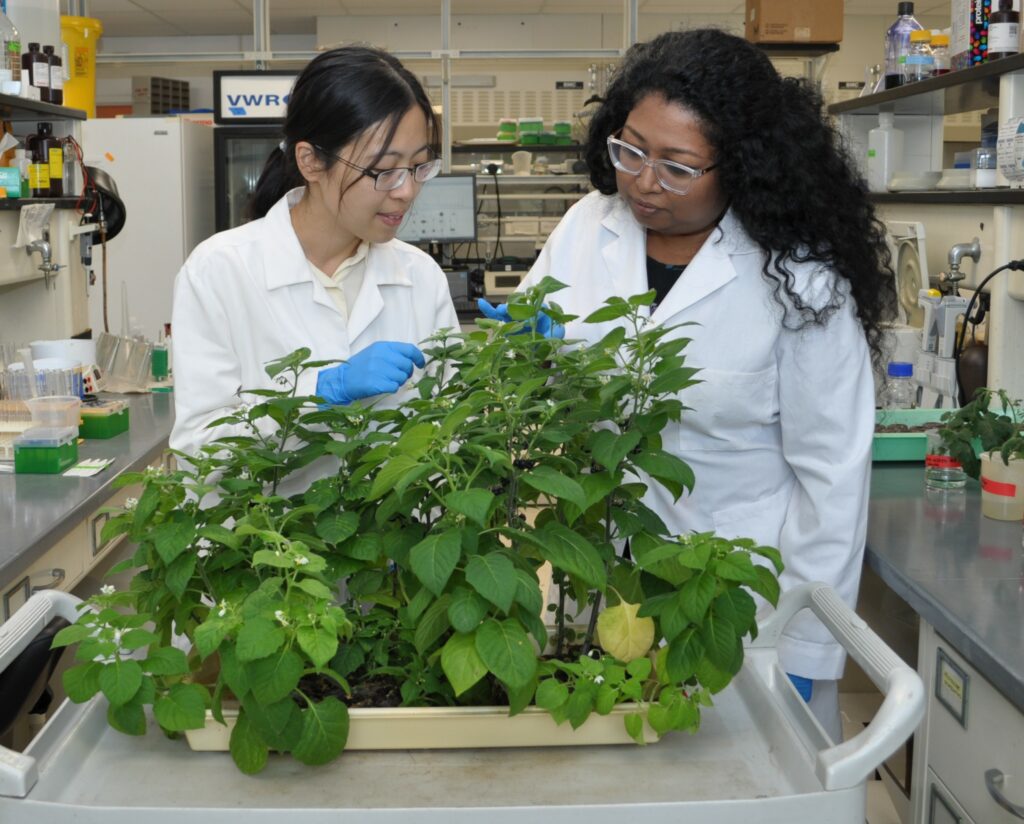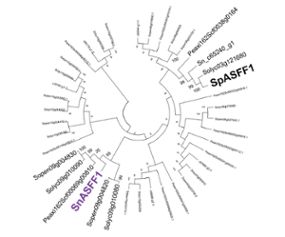Plants are master chemists, producing a dazzling array of molecules that are valuable to humans, including vitamins, pharmaceuticals and flavorings.
The largest and most diverse group of molecules are known as specialized metabolites. Some metabolites attract beneficial insects and others repel or kill herbivore insects that feed on plants or pathogenic microbes. Some of these metabolites are poised for action at the surface of the plant, being made in trichomes, which are small hairs on stems, leaves and flowers. Unfortunately, these natural defenses are often missing from crop plants, having been lost during domestication or advanced breeding.
For example, nightshade family (Solanaceae) plants synthesize sugar esters (acylsugars), which have anti-fungal and anti-herbivory activities. In species that accumulate and secrete large quantities, their sticky nature provides physical defenses as ‘glue’ adhering insect pest mouths and ‘flypaper’ entrapment of small-bodied insects.
However, cultivated tomato (Solanum lycopersicum) accumulates a relatively small amount of these acylsugars, and are undetectable on some other economically important Solanaceous crops, such as sweet pepper. Understanding how these missing metabolites are made in wild relatives can suggest breeding approaches to make crops more resilient to pests without use of chemical pesticides.

Yann-Ru Lou and Thilani Anthony collaborate to study how black nightshade (Solanum nigrum) makes a large number of distinct types of sticky acylsugars. Credit: Jeff Mason 
A novel type of invertase independently evolved twice in the trichome hairs of Solanum spp. and synthesizes acylglucose. These results illustrate the dynamic nature of specialized metabolite biosynthesis that contributes to the remarkable metabolic diversity found in flowering plants. Image: Yann-Ru Lou
In a paper published in Science Advances, a team of MSU scientists from the Michigan State University College of Natural Science followed up on their observation that the common black nightshade (Solanum nigrum) makes an unusually large number of different acylsugar protective compounds in their trichome hairs. The study took place in the laboratories of Biochemistry and Molecular Biology (BMB) University Distinguished Professor and Barnett Rosenberg Professor Rob Last, and MSU Mass Spectrometry Facility Director and BMB Professor Dan Jones.
“Because black nightshade makes so many acylsugars, we developed an accelerated acylsugar structure elucidation pipeline to speed up our study,” said Yann-Ru Lou, BMB postdoctoral researcher in the Last lab, and first author of the study. “We obtained structural information critical for enzymology without the time- and labor-consuming metabolite purification step by combining cutting edge analytical chemistry methods available at MSU.”
A surprise from this study is that black nightshade acylsugars have distinct types of compounds not found together in other plants: acylglucoses and acylinositols. These are based on the sugar glucose and vitamin-like substance inositol. Understanding how the wild species makes these two classes of protective molecules could lead to breeding of crops that can grow without synthetic pesticides.
“An exciting outcome of this work is the discovery of a novel type of invertase, the enzyme we normally think of being made by bees to produce honey and by yeast for fermentation,” Last said. This invertase evolved to be made in the trichome hairs and synthesize acylglucose, rather than the sweet glucose found in honey. The results illustrate the remarkable metabolic diversity found in flowering plants.”
In addition to Lou, Thilani Anthony from the Jones group, BMB graduate student Paul Fiesel and MSU undergraduate students Rachel Arking and Elizabeth Christensen contributed to the research.
Read the paper: Science Advances
Article source: Michigan State University
Image: Banner image: Genome edited tomato lines. Credit: Jeff Mason








